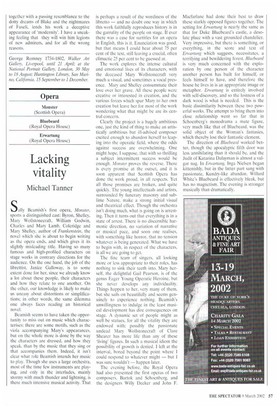Lacking vitality
Michael Tanner
Sally Beamish's first opera, Monster, sports a distinguished cast: Byron, Shelley, Mary Wollstonecraft, William Godwin, Charles and Mary Lamb, Coleridge and Mary Shelley, author of Frankenstein, the novel which she is about to begin writing as the opera ends, and which gives it its slightly misleading title. Having so many famous and high-profiled characters on stage works in contrary directions for the audience. On the one hand, the job of the librettist, Janice Galloway, is to some extent done for her, since we already know a lot about these people, their characters and how they relate to one another. On the other, our knowledge is likely to make us uneasy about distortions or simplifications; in other words, the same dilemma one always faces reading an historical novel.
Beamish seems to have taken the opportunity to miss out on music which characterises; there are some motifs, such as the viola accompanying Mary's appearances, but on the whole more is done by the way the characters are dressed, and how they speak, than by the music that they sing or that accompanies them. Indeed, it isn't clear what role Beamish intends her music to play. Though she uses a large orchestra, most of the time few instruments are playing, and only in the interludes, mainly stormy with much thunder and lightning, is there much intensive musical activity. That is perhaps a result of the wordiness of the libretto — and no doubt one way in which this work faithfully reproduces history is in the garrulity of the people on stage. If ever there was a case for surtitles for an opera in English, this is it. Enunciation was good, but that means I could hear about 75 per cent of the text, still leaving a crucial, often climactic 25 per cent to be guessed at.
The work explores the intense cultural and emotional lives of its characters, with the deceased Mary Wollstonecraft very much a visual, and sometimes a vocal presence. Mary and Shelley consummate their love over her grave. All these people were creative or interested in creation, and the various forces which spur Mary to her own creation hut leave her for most of the work wondering what that might be are its central concern, Clearly the project is a hugely ambitious one, just the kind of thing to make an artistically ambitious but ill-advised composer excited enough to abandon herself to leaping into the operatic field, where the odds against success are overwhelming. One might hope, I suppose, that with so thrilling a subject intermittent success would be enough. Monster proves the reverse. There is every promise at the outset, and it is soon apparent that Scottish Opera has done the work proud, in all respects. Yet all those promises are broken, and quite quickly. The young intellectuals and artists, surrounded by funerary masonry and sublime Nature, make a strong initial visual and theatrical effect. Though the orchestra isn't doing much, what is going on is arresting. Then it turns out that everything is in a state of arrest. There is no discernible harmonic direction, no variation of narrative or musical pace, and soon one realises, with something like horror, that no tension whatever is being generated. What we have to begin with, in respect of the characters. is all we are going to get.
The fine team of singers, all looking more or less appropriate to their roles, has nothing to sink their teeth into. Mary herself, the delightful Gail Pearson, is of the genus Eager Young Operatic Heroine, but she never develops any individuality. Things happen to her, very many of them, but she sails on beautifully and seems genuinely to experience nothing. Beamish's unwillingness to indulge in the least musical development has dire consequences on stage. A dynamic set of people might as well be statues, for all the vitality they are endowed with; possibly the passionate unclear.] Mary Wollstonecraft of Clare Shearer has more life than any of these 'living' figures. In such a musical idiom the possibility of growth is denied. I left at the interval, bored beyond the point where I could respond to whatever might — but I was sure wouldn't — happen later.
The evening before, the Royal Opera had also presented the first operas of two composers, Bartok and Schoenberg, and the designers Willy Decker and John F. Macfarlane had done their best to draw these starkly opposed figures together. The setting for Erwartung is nearly the same as that for Duke Bluebeard's castle, a desolate place with a vast grounded chandelier. Very impressive, but there is something, or everything, in the score and text of Erwartung which suggests, necessitates, a terrifying and bewildering forest. Bluebeard is very much concerned with the exploration by one person of the character another person has built for himself, or feels himself to have, and therefore the house he lives in is an appropriate image or metaphor. Erwartung is entirely involved with self-discovery, and so the lostness of a dark wood is what is needed. This is the basic dissimilarity between these two powerful works. The attempt to bring them into close relationship went so far that in Schoenberg's monodrama a mute figure, very much like that of Bluebeard, was the solid object of the Woman's fantasies, which thereby lost their fantastic element.
The direction of Bluebeard worked better, though the apocalyptic fifth door was less annihilating than it should be, and the Judit of Katarina Dal ayman is almost a vulgar nag. In Erwartung, Eng:a Nielsen began kittenishly, but in the latter part sang with passionate, Kundry-like abandon. Willard White's Bluebeard is effectively bleak, but has no magnetism. The evening is stronger musically than dramatically.














































































 Previous page
Previous page